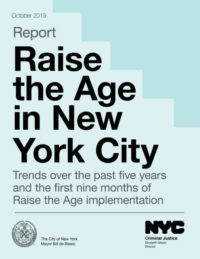Raise the Age in New York City
Trends over the past five years and the first nine months of implementation.
In April 2017, New York State passed Raise the Age legislation, ending automatic prosecution of 16- and 17-year-olds as adults. In doing so, Raise the Age aimed to go beyond simply changing how young people were being handled by the courts. It also sought to provide age-appropriate services and facilities that would promote an environment focused on wellbeing for young people.
The law went into effect in October 2018, also requiring the City to move all 16- and 17-year-olds out of jails on Rikers Island, and into more age-appropriate facilities. The law first brought 16-year-olds in under the new system, which moved all young people’s cases into court systems specialized for juveniles and adolescents. Most misdemeanors are now handled through Family Court. A new Youth Part was created in the state Supreme Court, where felonies are now arraigned. Judges there decide whether to remove the case to Family Court or to continue to hear them in the Youth Part. During the first year with just
16-year-olds, nearly 80% arraigned in Youth Part were removed to Family Court.
Following broader trends in the criminal justice system, Raise the Age comes amid a rapidly shrinking juvenile justice system. From 2013 to 2018, juvenile arrests—those ages 15 and under—dropped by 55%. Over that same time period, adolescent arrests of 16- and 17-year-olds decreased by 60%. Over the first nine months under the new law, declines in misdemeanor arrests of 16-year-olds were 61% lower compared to the same time period from October 2017 to June 2018.
As of October 1, 2019, 17-year-olds will no longer be treated automatically as adults under the same new system. The report that follows demonstrates that Raise the Age amplified many of these already steep reductions in the juvenile justice system.



